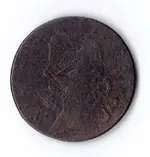It's a counterfeit George II halfpenny referred to as an Evasion. Very cool find but not usually worth much.
Evasion Issues
Along with counterfeits there were several "evasion issues" produced in England and Ireland. These issues did not try to make exact copies of coppers (usually halfpence), instead they only tried to closely resemble regular issues. Usually the images would be the same but the motto "Georgius III Rex" would be changed to "George Rules", "Georgius III Pax", "Britain Rules" or the like. Sometimes the portrait of the king would face in the wrong direction. Since these coins were not exact copies of regal issues, the makers could not be charged with counterfeiting under English law.
Some individuals turned to evasion pieces as early as the 1750's but the majority were produced after counterfeiting coppers was made a felony in 1771. Newman (pp. 151-153) has traced the history of evasion coins and found they were not used in America. The idea that evasion coppers were used in America was first posited by the German coin dealer S.K. Hazfeld who came to Philadelphia in 1877 and introduced evasion coppers to the American numismatic community. The New Jersey specialist Edward Maris believed evasion coins were indirectly referred to the July 14, 1781 document signed by John Reed, the president of the Supreme Executive Council of Pennsylvania that is quoted above, which stated "Divers ill-disposed persons have manufactured or imported into this State quantities of base metal, in the similitude of British half-pence". Maris felt similitude referred to evasion rather than counterfeit coppers. Clearly this is a distinction Maris could easily make, but his error was in supposing it was a distinction John Reed understood and was trying to make. Rather it seems Reed simply used this term to refer to counterfeit coppers as similar to the regal coins. Most later coin dealers followed Hazfeld and Maris in describing evasion pieces as having been used in America. Newman has explained no evasion copper has ever been found in excavations at an American site nor has one appeared in a colonial coin hoard. Recently, Philip Mossman has concurred in this opinion stating: "there is no evidence that evasive halfpence ever circulated in America nor is there any report of such pieces being recovered in accumulations or hoards from the colonial period." (Money of the American Colonies p. 123). In fact, it would seem reasonable that counterfeiters, under fear of prosecution, would want to send their products out of the country, while there was no such incentive for the export of evasion issues.





 yet
yet

